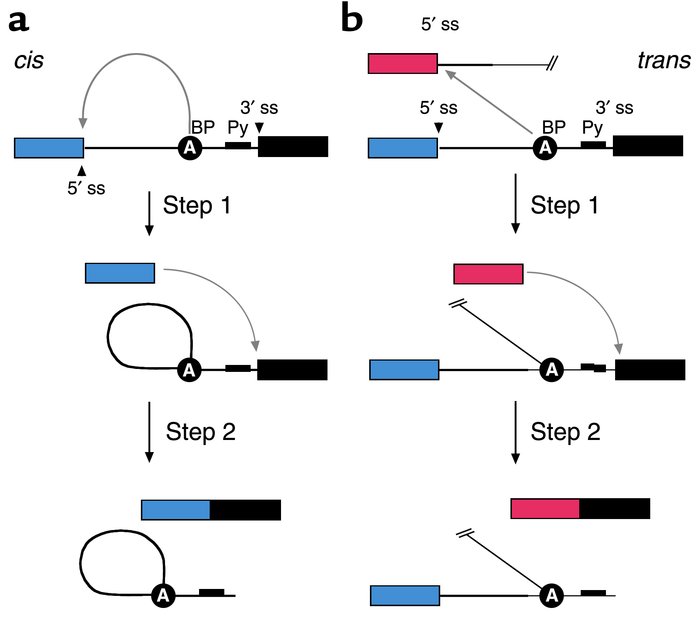Mariano A. Garcia-Blanco
Citation Information: J Clin Invest. 2003;112(4):474-480. https://doi.org/10.1172/JCI19462.
Mariano A. Garcia-Blanco
Published August 15, 2003
Citation Information: J Clin Invest. 2003;112(4):474-480. https://doi.org/10.1172/JCI19462.
Abstract
In the human genome, the majority of protein-encoding genes are interrupted by introns, which are removed from primary transcripts by a macromolecular enzyme known as the spliceosome. Spliceosomes can constitutively remove all the introns in a primary transcript to yield a fully spliced mRNA or alternatively splice primary transcripts leading to the production of many different mRNAs from one gene. This review examines how spliceosomes can recombine two primary transcripts in trans to reprogram messenger RNAs.
Authors
Mariano A. Garcia-Blanco
Figure 2
Options:
View larger image
(or click on image)
Download as PowerPoint
Both cis -splicing and trans -splicing reactions proceed via two phosphoryl transfer reactions. (a ) The cis reaction. A schematic of the two phosphoryl transfer reactions required for intron removal (16 ). The exons are indicated as boxes (the first or 5′ exon is gray and the second or 3′ exon is black), and the intron is depicted as a line. In the first reaction (step 1), the 2′ OH group of a bulged adenosine at the branchpoint attacks the 5′ phosphate of the first residue of the intron forming the lariat intermediate and the “free” 5′ exon. The lariat contains the branched adenosine, so called because it is connected via conventional 5′ and 3′ links, but also contains a 2′-5′ linkage to the first residue of the intron (see ref. 16 for a more extensive discussion of the splicing reactions). In the second step, the 3′ OH group of the last residue of the “free” 5′ exon attacks the 5′ phosphate of the first residue of the second exon, forming a product with the two exons ligated and releasing the intron as a lariat. (b ) The trans reaction. A schematic of the two phosphoryl transfer reactions required for SMaRT. Icons are as described above, except that the trans -splicing or invading exon is shown as a red box. In step 1, the 2′ OH group of the bulged or branchpoint adenosine is again the nucleophile and is attacking the 5′ phosphate of the first residue of an intron in a second RNA molecule (this molecule could be identical in sequence to the first or it could be a completely different RNA). Because the reaction proceeds in trans the branched molecule is now a Y-shaped molecule, not a lariat. Step 2 proceeds as described for step 2 in the cis reaction; however, the exon product includes sequences from two RNAs.



Copyright © 2025 American Society for Clinical Investigation
ISSN: 0021-9738 (print), 1558-8238 (online)

